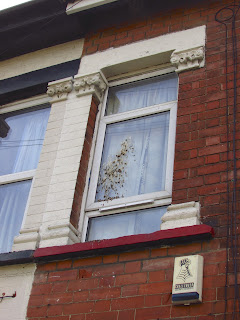The House Martin is a relative of the Swallow with a strong preference for urban habitats. Upper parts, wings and tail are mostly dark with metallic reflections on head and back, with white underparts, throat and rump. The tail is forked but lacks the long streamers of the Swallow. Its legs and feet are feathered. Juveniles are browner than adults and have white edges in tertiary wing feathers. House Martins spend most of their time on the wing, feeding on flying insects. They breed in colonies, with nests made of mud pellets that they construct under eaves, gables windows and other overhangs in buildings or other human constructions. When abundant, nests are often built adjacent to each together. Mud collecting is also a social activity. Originally House Martins nested in natural cliffs. A colony nesting in cliffs survives at the Flamborough headland.
Status and distribution in Hull
House Martins are scarce summer breeders, but are more common as passage migrants in Hull. They can be seen from the last week of April to the beginning of October with a strong autumn passage over the city at the end of August and beginning of September. Colonies in Hull tend to be small and scattered thinly around the city, and some, like those in Newland and Chanterlands avenues, have been lost in recent years. Known existing colonies are at Albert Dock, Victoria Dock Village, Marists Hall, Bransholme, and Sidmouth Primary School, but there will be others. Individuals tend to hunt near their nests when breeding, which may help locate active colonies. Some buildings are favoured and the pairs return and rebuild their nests, even when their last year nests have been lost or destroyed (as at Sidmouth Primary School, top shot, 15th May 2014).
Conservation
The House Martin was recently moved from Amber to Red-listed due to long-term population declines. Between 1970 and 2014 the population halved in size, with the steepest declines until the 90s, but are still ongoing. There has been a more marked decline in the southern half of the UK. Reasons for the decline are unclear, but could be related to decreased insect or nest site availability or problems in their wintering grounds in Sub-Saharan Africa. House Martins can also have their nests taken over by House Sparrows.
The small price to pay for hosting House Martin nests may be a dirty window pane or a pile of droppings on a windowsill. This can be remedied by the use of a "dropping board" that will collect the droppings and can be removed and cleaned easily.
Management
- Discourage people/companies from removing existing nests. Removing active nests is illegal.
- Install artificial nests to compensate for nest loses, particularly in new houses with plastic soffits. It takes 10 days and many mud collecting trips to make a nest from scratch and bird having to rebuild a nest are less likely to attempt 2nd broods.
- Lack of soft mud near colonies can be an issue, as it needs to be available less than 300 m away from the colony. In colonies near the River Hull or the Humber this shouldn't be an issue, but in other areas the public could be encouraged to modify ponds to have a section of muddy edge or muddy puddles could be created in corners of car parks or other public spaces.
- Educating the public about these birds may reduce the rate of nest destruction and encourage people to fit artificial nests under their eaves.
- Monitoring. Usual bird surveys are not ideal to monitor House Martin populations. Encourage members of the public to submit active colony records to Birdtrack.
More information










No comments:
Post a Comment